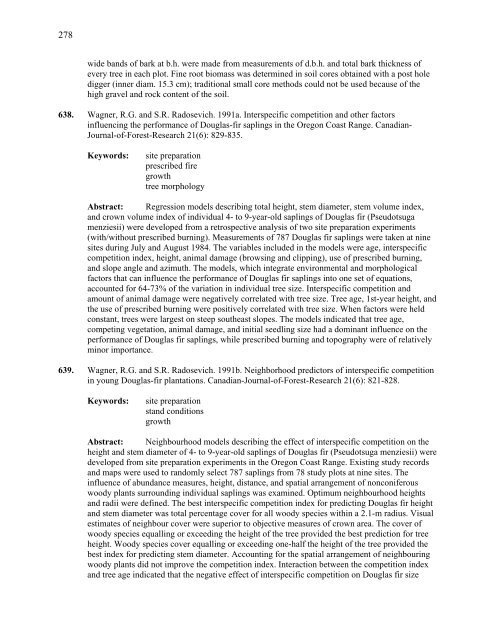IntensIve sIlvIculture - Forest Science Labs - Research Network ...
IntensIve sIlvIculture - Forest Science Labs - Research Network ...
IntensIve sIlvIculture - Forest Science Labs - Research Network ...
Create successful ePaper yourself
Turn your PDF publications into a flip-book with our unique Google optimized e-Paper software.
278<br />
wide bands of bark at b.h. were made from measurements of d.b.h. and total bark thickness of<br />
every tree in each plot. Fine root biomass was determined in soil cores obtained with a post hole<br />
digger (inner diam. 15.3 cm); traditional small core methods could not be used because of the<br />
high gravel and rock content of the soil.<br />
638. Wagner, R.G. and S.R. Radosevich. 1991a. Interspecific competition and other factors<br />
influencing the performance of Douglas-fir saplings in the Oregon Coast Range. Canadian-<br />
Journal-of-<strong>Forest</strong>-<strong>Research</strong> 21(6): 829-835.<br />
Keywords: site preparation<br />
prescribed fire<br />
growth<br />
tree morphology<br />
Abstract: Regression models describing total height, stem diameter, stem volume index,<br />
and crown volume index of individual 4- to 9-year-old saplings of Douglas fir (Pseudotsuga<br />
menziesii) were developed from a retrospective analysis of two site preparation experiments<br />
(with/without prescribed burning). Measurements of 787 Douglas fir saplings were taken at nine<br />
sites during July and August 1984. The variables included in the models were age, interspecific<br />
competition index, height, animal damage (browsing and clipping), use of prescribed burning,<br />
and slope angle and azimuth. The models, which integrate environmental and morphological<br />
factors that can influence the performance of Douglas fir saplings into one set of equations,<br />
accounted for 64-73% of the variation in individual tree size. Interspecific competition and<br />
amount of animal damage were negatively correlated with tree size. Tree age, 1st-year height, and<br />
the use of prescribed burning were positively correlated with tree size. When factors were held<br />
constant, trees were largest on steep southeast slopes. The models indicated that tree age,<br />
competing vegetation, animal damage, and initial seedling size had a dominant influence on the<br />
performance of Douglas fir saplings, while prescribed burning and topography were of relatively<br />
minor importance.<br />
639. Wagner, R.G. and S.R. Radosevich. 1991b. Neighborhood predictors of interspecific competition<br />
in young Douglas-fir plantations. Canadian-Journal-of-<strong>Forest</strong>-<strong>Research</strong> 21(6): 821-828.<br />
Keywords: site preparation<br />
stand conditions<br />
growth<br />
Abstract: Neighbourhood models describing the effect of interspecific competition on the<br />
height and stem diameter of 4- to 9-year-old saplings of Douglas fir (Pseudotsuga menziesii) were<br />
developed from site preparation experiments in the Oregon Coast Range. Existing study records<br />
and maps were used to randomly select 787 saplings from 78 study plots at nine sites. The<br />
influence of abundance measures, height, distance, and spatial arrangement of nonconiferous<br />
woody plants surrounding individual saplings was examined. Optimum neighbourhood heights<br />
and radii were defined. The best interspecific competition index for predicting Douglas fir height<br />
and stem diameter was total percentage cover for all woody species within a 2.1-m radius. Visual<br />
estimates of neighbour cover were superior to objective measures of crown area. The cover of<br />
woody species equalling or exceeding the height of the tree provided the best prediction for tree<br />
height. Woody species cover equalling or exceeding one-half the height of the tree provided the<br />
best index for predicting stem diameter. Accounting for the spatial arrangement of neighbouring<br />
woody plants did not improve the competition index. Interaction between the competition index<br />
and tree age indicated that the negative effect of interspecific competition on Douglas fir size
















